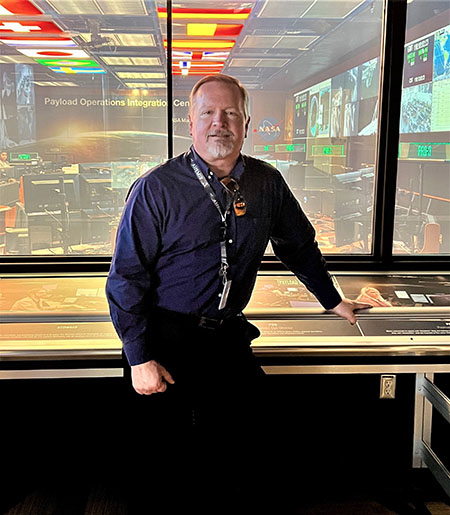Walter Petersen named 2022 Outstanding Alum
Walter Petersen, chief of the Science Research and Projects Division at NASA Marshall Space Flight Center, has been selected as the department’s 2022 Outstanding Alum.
Petersen received his M.S. (1992) and Ph.D. (1997) from the department, studying with Professor Steven Rutledge. His dissertation was “Multi-Scale Process Studies in the Tropics: Results from Lightning Observations.”
Petersen continued as a research associate in the department until 2002, when he accepted a position as senior research scientist in the National Space Science and Technology Center at the University of Alabama-Huntsville. Petersen served as science director for the UAH ARMOR dual-polarimetric Doppler radar facility.
In 2008, he became a physical scientist at NASA Marshall Space Flight Center, and in 2011, he became a supervisory research physical scientist and the branch chief of the Earth Science Field Support Office at NASA Goddard Space Flight Center’s Wallops Flight Facility. Petersen returned to NASA Marshall Space Flight Center in Huntsville as division chief in 2015, where he leads 200 scientists, engineers and technical specialists.
Petersen’s research spans many topics in cloud physics, mesoscale meteorology and radar meteorology, and he has made seminal contributions in remote sensing of tropical convection, the relationship between lightning and updraft strength, and how cloud-to-ground lightning relates to convective rainfall.
Among his many leadership roles, Petersen has been a principal leader of the calibration and validation of the NASA Global Precipitation Mission (GPM), providing an essential and sustained contribution to a major program of NASA’s Earth Science Directorate. He led the NASA-JAXA GPM ground validation program from 2011-2019 and helped organize eight associated field programs.
Petersen has authored or coauthored at least 105 peer-reviewed journal publications, which have been cited more than 11,000 times. He is well known for his dedicated service to the atmospheric science community, including as chair of the AMS Committee on Atmospheric Electricity.
Petersen was elected an AMS Fellow in 2020 and has received numerous other awards, including the NASA Exceptional Scientific Achievement Medal in 2018. He was nominated for the Outstanding Alum award by Rutledge and University Distinguished Professor Emeritus Graeme Stephens.
Petersen will be honored in a ceremony later this semester or early next year, when he will have the opportunity to present his work.
Note from Petersen:
I offer my sincere thanks to the Department of Atmospheric Science for this award. This honor is certainly not something I would have envisioned when joining the department as a graduate student back in 1990. There is no question that it is the result of the excellent education, coaching, mentoring, dedication, and more than occasional personal counseling and guidance offered by faculty, colleagues, fellow classmates, and most especially, my research advisor, Professor Steve Rutledge. Within the broader supporting infrastructure of the department, Steve did not just provide the opportunity to learn, he also provided me the examples and tools required to succeed in the role of a Ph.D.-level scientist; i.e., how to learn, do research, manage a field project, communicate, and how to lead. Those lessons were routinely reinforced by the faculty, students, and researchers that I was fortunate enough to interact with while at the department.
My rounded “education” in the department involved a great deal of one-on-one counseling from any number of faculty in any number of situations – and it was all good advice, much of which I relate to students I advise to this day. I was also fortunate to have been a member of a tight group of “well-seasoned” and personable graduate students in Radarmet. These people became the absolute best support group I could have ever hoped for while at CSU. To this day, I feel a special connection to those folks – they reflect the best of an integrated set, a standard really, of personal qualities blended with intellect that CSU Atmospheric Science attracts.
Finally, there is no question that my professional direction has benefited from myriad field campaign adventures focused on studies of convection, lightning and precipitation using advanced radar technologies that are characteristic of a place like CSU. I got to experience the “atmospheric laboratory” from the jungles of the Amazon, the beautiful isolation of both the tropical western and eastern Pacific Ocean, and of course closer to home in Colorado and on the Great Plains. The field experiences, combined with the science knowledge, personal interactions, and all the science leadership skills taught explicitly or implicitly to me while being at CSU, brought me to where I am today. What a ride!
My sincere thanks again for this award and the integrated set of experiences and opportunity that laid the foundation for my receiving it.



